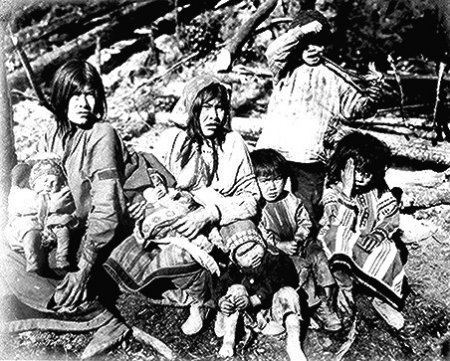 | ||
The indigenous peoples of Yukon were the sole inhabitants of the Arctic coastal territories prior to arrival of Europeans. The indigenous people of Yukon are part of the Aboriginal people of Canada. Traditionally, the Yukon indigenous peoples are hunters and gatherers with close connections to the land, the rivers and the seasons. Their history is recorded and passed down generations in an oral tradition. European contact brought many changes to the indigenous people of Yukon including land loss and non-traditional governance and education. However, the Yukon indigenous peoples continue their connections with the land in seasonal wage labour such as fishing and trapping. In Yukon First Nation organisations the people are aim for maintenance and development of indigenous education, language, culture, spirituality and Aboriginal rights.
Contents
Pre contact
People arrived in the Yukon around 11000 BCE via the land bridge of the Bering Strait The Mount Saint Elias region, in the far southwest of the Yukon Territory was unsettled. The Inuit (Eskimo) people occupied the Arctic coast of modern Yukon, including Herschel Island.
Population
The population of indigenous people of the Yukon prior to arrival of Europeans is uncertain. The number at the beginning of the nineteenth century most likely lies between 7000 and 9000 or more. By 1830, there were approximately 4700 indigenous people living in the Yukon.
Tribal groups
The Yukon was inhabited by six principle indigenous tribes: Kutchin, Hän, Kaska, Tagish, Tutchone and Teslin.
The Kutchin occupied the basins of the Peel River and the Porcupine River. Relatives of the Kutchin, the Hän, lived at the middle reach of the Yukon River at the border with Alaska. The Northern Tutchone tribe inhabited the central Yukon in the basins of the Pelly River and Stewart River. They also inhabited Southern Tutchone, southwest of Yukon. The Kaska lived southeast of Yukon, in a basin of the Liard River. In the south, near lakes in the upper course of Yukon there lived the Tagish, who were related to the Kaska. In the southwest, in the river heads of the White River, were the Upper Tanana.
In the south, along the Teslin River, were continental Tlingit (Teslin), whose language, together with the Athabaskan languages, is included in the Na-Dene language family.
Language
The pre-contact peoples of Yukon spoke dialects within the Athabaskan languages. The Athabaskan languages themselves are a subset of the Na-Dene language family. The Cree Syllabary developed by the Methodist missionary, James Evans was adapted for use in the Yukon. Missionaries of many Christian denominations wrote dictionaries, grammars and religious texts in the indigenous languages, often with the assistance of translators.
Traditions
The indigenous people of the Yukon had a land based oral tradition. The people were hunters and gatherers, skilled in following the season changes in food sources. There was fishing and trapping in the valleys. Specific prey were followed to higher areas.
Knowledge about many aspects of pre contact tradition such as animal behaviour, land use, subsistence, textiles, language and spirituality comes from the oral history of indigenous people and from the work of scientists such as archeologists and anthropologists.
European contact
Contact between the Indigenous people of the Yukon and European fur traders began in the 1840s. The Hudson's Bay Company entered the area of the Yukon around that time.
Through the 1800s, indigenous people such as the Han along the Alaska-Yukon border trapped for furs to trade for European manufactured items.
The Klondike gold rush of 1896 was a seminal moments in post contact history of the indigenous people of the Yukon. Not only did the influx of Europeans bring new diseases, missionary movements and European consumer items but also the indigenous peoples found a role as guides, packers and chandlers for prospectors.
In 1898, the increased European population led to formalisation of governance in the formation of the Yukon Territory.
Aboriginal land claims
In the late 1960s, the Yukon Indian Advancement Association was formed. In 1970, the Yukon Native Brotherhood was founded, commencing a land claims movement. In 1973, the Together Today for Our Children Tomorrow petition was presented by Elijah Smith to the prime minister Pierre Trudeau.
In 1990, the Yukon Final Umbrella Agreement was completed.
Twenty-first century
In 2006, approximately twenty-five percent of the population of the Yukon Territory were indigenous people. Only twelve percent were fluent in the language of their nation. Fourteen First Nations represented eight language groups. In 1991, an ongoing program for preservation of these languages was begun in Voices of the Talking Circle, the proceedings of the Yukon Aboriginal Language Services which emphasised that the people are the proper stewards of their languages and maintaining a critical mass of fluent speakers is essential.
First Nations
This is a list of the fourteen First Nations of indigenous people of Yukon.
